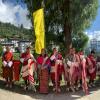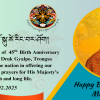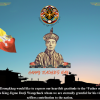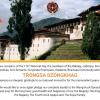JIGME SINGYE WANGCHUCK NATIONAL PARK
Centrally located and encompassing a wide altitudinal variation & vegetation, JigmeSingyeWangchuck National Park is the third largest Protected Area in the Country. The park borders Royal Manas National Park in the south and it is connected to JigmeDorji National Park and Wangchuck Centennial National Park to the north and Phrumsengla National Park to the north east by biological corridors, thus forming a contagious belt between tropical south and alpine north. Administratively, JSWNP covers 5 districts partially.
The 1730 sq.km national park was gazetted in 1995 with objective of securing ecological connectivity and managing & conserving the natural & cultural heritages of Central Bhutan. JSWNP best represents the middle Himalayan ecosystem & contains several ecological biomes ranging from sub-tropical to alpine meadow. The biologically diverse park has recorded the presence of 39 mammals, 270 birds, 139 species of butterflies, 16 fishes, and we are yet to establish the baseline for herpeto fauna, fungal diversity and diversity of orchids and herbal plants.
Amongst the mammals, the species includes some of the Asia’s most charismatic species including the Royal Bengal tiger, golden langur, musk deer, clouded leopard, golden cat, marbled cat, red panda, gaur etc. Birds of conservation significance include Rufous-necked Hornbill, Satyr tragopan and Himalayan Monal. JSWNP also harbours 50% of the population of ‘Critically Endangered’ White-bellied Heron.
Over 5000 people reside in the national parks 588 households spread over 6 geogs partially in five districts adapting to various climatic conditions and vegetation covers.
The mission of the park is to “Conserve and manage its Natural Biodiversity in harmony with People’s Values and Aspirations.” This mission is supported by following goals;
(a) Conserve, protect and maintain the viability of specific ecosystems, that would allow natural processes of succession and evolution to continue with minimal human influence.
(b) Protect cultural, historical and religious sites.
(c) Contribute to the socio-economic development of park residents through sustainable use of park natural resources.




